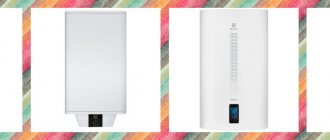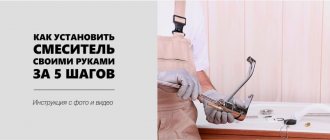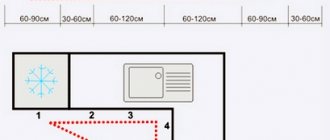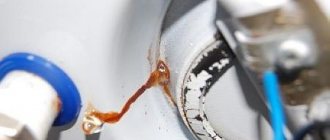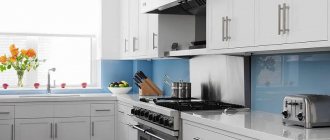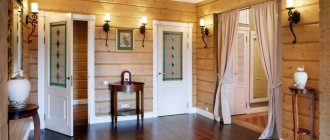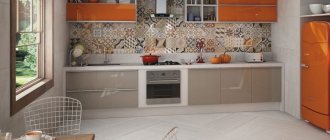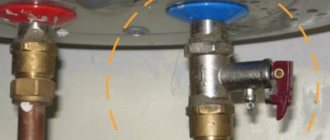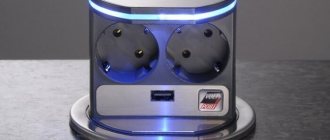Hi all! I can say with confidence that a water heater for the kitchen is an important, and sometimes irreplaceable, attribute in the home of a modern person. It is much more comfortable to wash dishes and do everyday household chores when warm or hot water is available from the tap.
But it is difficult to give a definite answer regarding only which option is better to choose - flow-through or storage. It all depends on the specific goals that the water heater has, as well as on related factors that can influence your choice to one degree or another.
To answer this question, you need to study the types and capabilities of water heaters, and find out what each of them is capable of and in what situations it can be useful. Be sure to leave your feedback and opinion regarding this issue.
Types of water heaters
The progenitor of all modern models that help to have hot water is a gas water heater. Where it is not possible to install it, an alternative is a later and less fire-hazardous electric analogue for the kitchen. If desired, you can choose modifications with a mechanical control method or an improved automatic, which is a guarantor of safety, since it is capable of independently shutting off the gas supply if it suddenly goes out or the draft stops. According to the operating principle, all water heaters are divided into the following types.
Flow-through
The gas flow type in a modern design appears as a compact, aesthetic column connected to the main line. It fits perfectly into the kitchen ambience in the space under the sink, as the range comes in different colors.
The disadvantage that owners of such devices usually consider is that the supply of heated water stops as soon as the gas is turned off. Such water heaters save during planned outages of hot water supply and are an excellent lifesaver in the country.
An electric instantaneous water heater for the kitchen looks like a small box with a tap coming out of it, from which water flows to the desired degree of heating. Such a device is connected to the water supply system. Running water, passing through the heating element, receives heat and is used for domestic needs. Such a device is convenient for placement in a small kitchen where significant volumes of hot liquid are not required.
Cumulative
This water heater is attractive due to the design of the tank - a thermos, which stores heated water for a long time. This variation of the boiler is economical, since the device is turned on to bring the required volume of liquid to the desired temperature, and then turns off. Gas varieties are not as compact as their flow-through counterparts, but have a sufficient range of dimensions and excellent decor to fit under the sink in the confines of the most stylish kitchen.
Most electric storage water heaters are a full-fledged automatic boiler, which independently, following the programmed program, performs all the basic functions: turns on, heats the water to the required temperature, turns off. Such a device must be constantly connected to the network.
Pressure and non-pressure
Also be sure to pay attention to what kind of water heater you choose - pressure or non-pressure.
See also
Repair of laminated chipboard countertops: do-it-yourself restoration
- Gravity devices have internal pressure approximately at atmospheric pressure. This is ensured by using a special tap at the entrance. A good option for a kitchen sink, which is located directly above the sink itself. The kit often comes with a special nozzle that makes washing dishes easier. The devices are low-power, and therefore installing them yourself and connecting them to a household outlet is not scary;
- Pressure models are flow-through heaters, where there is an inlet and outlet necessary for water drainage. They turn on automatically as soon as the tap opens. If the water is turned off, then heating stops. They fit perfectly under the sink, where the space is usually not particularly used. Great space saver.
When you visit any household appliance store in cities such as St. Petersburg, Moscow, Krasnodar or Tver, you will come across a huge assortment of heaters. But it’s difficult to say for sure which one to choose and why one or another option is better.
Performance
In order for storage water heaters to fully meet expectations, you should determine the average volume of warm water used and install a boiler, choosing a suitable tank from a standardized line:
- 10 liters is an option ideal for a married couple;
- 15 liters – a model that can satisfy the needs of three people;
- 20 liters is a modification of a storage water heater from the category of universal devices, providing comfortable conditions in the kitchen for a family of almost any composition.
Volumes of 25 liters can be found, but they will disappoint with their low efficiency, so for the kitchen of a living space where a large family lives, instantaneous water heaters are recommended that are not limited by the dimensions of the tanks.
How to stylistically design a room with a boiler
To make the room attractive after installing the boiler device, it is necessary to use the following stylistic design options:
- Provence is attractive because it combines white facades with a water heater painted in a similar tone. It is possible to use designs with flowers.
- The loft style uses the device effectively.
- It is characterized by the presence of a delicate country-style color palette. The structure can be covered with panels painted blue, white or peach.
The product is also installed in rooms decorated in rustic, industrial, Russian and a number of other styles.
Power
When purchasing a boiler, you need to carefully consider the issue of comparing the power of the device with the capabilities of the existing electrical wiring. In houses with central gas supply, it may not be able to withstand the connection of an additional device, which on average consumes 3.8 kW. For this reason, only a specialist can give recommendations on whether communications will need to be replaced. If there is an electric stove in the kitchen, a preliminary consultation will not be superfluous regarding the possibility of simultaneously turning on it and the water heater at full power.
Cumulative gas
Of course, this is a more convenient option. In this case, the tank with a certain amount of water heats up and, thanks to the design of the “thermos”, retains hot water for a long time. In this case, of course, the consumption will be less. That is, the column is turned on in order to bring the water to a certain temperature or a given range.
Such water heaters are less compact, but due to the structure of the body, color and shape, they can harmonize well with the rest of the inhabitants of the kitchen. By the way, in the photo the gas storage heater and the flow-through heater differ mainly in dimensions.
At the same time, fulfilling its main purpose - providing hot water. In addition, such a device can be installed outside the kitchen. This could be a bath, toilet, pantry, with the only caveat - compliance with all safety standards.
In addition, gas heaters can be electronic, automatically turned on or mechanically controlled. The cost of the device depends on these parameters. There are specimens that, when there is no thrust or attenuation, independently block the gas supply, which is very convenient. After all, do not forget that the geyser has a certain degree of fire and explosion hazard.
Safety and check valve
For flawless operation, any boiler requires the installation of a check valve in the kitchen water supply system, which is additionally combined with a safety analogue. The function of the last valve is to regulate the increase in water pressure above normal by bleeding water. In this case, there may be a slight leakage of moisture, which is normal. The check valve prevents excess moisture from the water supply from entering the water heater.
Having a large boiler, it is advisable to provide an expansion tank to collect the water that flows out during the increase in pressure. It is placed between the area where the safety valve is located and the water heater.
Main types of water heater breakdowns
Main breakdowns of electrical structures:
- heating element failure;
- storage tank leaking;
- clogging of all kinds of ducts;
- thermostat failure.
In any case, you should not try to fix the problem yourself. To do this, it is better to contact a service center. If the product does not come with the warranty provided by the manufacturer or store, then contact them immediately. After all, after independently tampering with the device, the warranty is automatically canceled and all repair costs are borne by the buyer.
Installation of a water heater in the kitchen under the sink
All consumables necessary to fix a modern water heater directly under the sink are included as standard. The installation algorithm in a kitchen is not particularly difficult and can be done independently.
- Attach shut-off valves to the pipes of the storage tank included in the kit.
- Secure the check valve to the cold water pipe. The faucet is screwed directly onto the valve, which is then connected to the pipeline with an adapter.
- Attach the faucet to the second hot pipe, and also provide it with a hose or metal-plastic end cap to secure it to the pipe.
- Dismantle the mixer hoses.
- Connect the boiler with appropriate connections, providing for sealing, for which tow is often used.
- Electrical wiring is laid from the panel with a local circuit breaker provided, an outlet is equipped and the water heater is connected.
A convenient option is a method where a boiler of sufficiently high power is mounted in the bathroom with a parallel outlet for the supply of heated water to the sink and the creation of a second distribution towards the kitchen.
Flow-through
Their advantages are that they do not take up much space. Thanks to its compact size, it can be installed in a cabinet under the sink.
The disadvantages of such a heater are that it is impossible to simultaneously obtain a large flow of water. Another disadvantage is the comparatively higher electricity consumption due to higher power.
Keep in mind that the more powerful the heater, the greater the load on the electrical network. For apartments in old buildings, it is recommended to choose equipment with a power of no more than 5 kW.
The price starts for such heaters from 1,000 rubles.
Reviews from customers
Maria, Moscow : “We installed a flow-through, non-pressure kitchen water heater. Convenient to use. But after 8 months the water pressure became less. It turned out that the diffuser needed to be replaced due to the fact that it was clogged with debris from the water supply. The procedure is not very complicated, but I did not expect to carry out maintenance so often.”
Sergey, Moscow : “I have a 100 liter storage boiler installed. We set the temperature ourselves as desired. The warmer the weather outside, the lower the water heating temperature. It is very convenient and economical. A family of three, so the volume is quite enough. Moreover, the wiring is at three points: bathroom, washbasin and kitchen. We are satisfied".
Installing a water heater in the bathroom
Any type of water heater can be installed in the bathroom, but the water supply can be routed to the kitchen. Such a device will be more powerful. In this case, it will be necessary to conduct double wiring - to the bathroom and to the kitchen.
Wall mount
Installing a water heater yourself includes mounting it on the wall. This is a heavy unit. Installing the boiler on the wall is done only on concrete or brick using anchor bolts.
If the wall is crumbling, then the length of the anchor bolt should be longer. First, a hole is drilled in the wall, a plastic component is inserted into it, and bolts are screwed into it.
Such devices can only be attached to walls made of foam concrete, foam blocks and other similar materials, not to mention plasterboard, only with the help of special additional fasteners.
Water connection
Boilers are attached to the water supply through pipes for hot and cold water. They are painted in traditional colors: blue for cold water connection, red for hot water.
First, the safety valve is connected to the blue pipe. A check valve is screwed onto this valve. Then two ball valves are inserted.
All parts must be sealed and checked for leaks. To achieve maximum sealing, use tow or special “fum” tape.
It is better to attach the boiler to the water pipes with metal-plastic pipes. It is also possible to use a flexible line, but it does not always withstand pressure changes and water hammer.
Metal-plastic pipes do not bend, but are connected using fittings. Water connection diagram:
Water connection diagram
Electrical connection
The installation diagram of the water heater is designed for the electrical cable to be connected directly to the panel. The machine in the panel must be turned off in case of an emergency. No special permission is required for such a connection.
Consumables for water connection
Installing a water heater yourself requires purchasing additional materials. To connect to the water supply:
- Ball valves in the amount of 2-3 pieces, depending on the connection method.
- Metal-plastic pipes. The footage depends on the distance from the water heater to the pipe. Diameter ½ inch. You can use flexible eyeliner, but its shelf life is limited.
- Elements for fastening pipes to the wall (clips), and to each other (fittings).
- Pressure regulator.
- Filter for water purification.
To connect to electricity:
- Electrical cable, copper, three-core. The cross-section of one core is at least 2 mm.
- Cable box or fastener.


